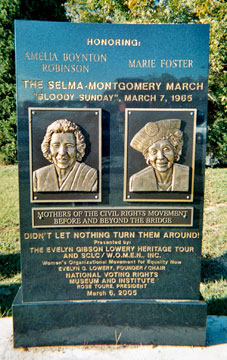Bridge Crossing Jubilee,
44th Anniversary of “Bloody Sunday”
by
Kesha Rogers and Gabriela Arroyo Reyes
Selma, Alabama
March 2009
 |
The same nation, whose veritable founding , as far back as the Boston Tea Party, was itself a representation of the principle of massive disobedience and defiance of the established laws of the British Empire for a higher moral natural law, would come to unfold in an ironic twist of fate, as the scene for “Bloody Sunday”. It would not be the first time in the long trials and tribulations of man's fight for justice that would be marked by civil disobedience, but it would be one that shook the moral fiber of society down to its very foundation. What would later come to be recorded in the annals of history as the largest demonstration of civil disobedience, took place on a Sunday morning of March 7, 1965, despite a ban issued by Governor George Wallace on all protest marches. Some 600 civil rights marchers gathered outside Brown Chapel AME to peacefully march from Selma, Alabama to the state capital in Montgomery. They proceeded onward valiantly and vigorously, but were met six blocks away at the foot of the Edmund Pettus Bridge by the brutality of state and local troopers who were ordered to charge violently against them with billy clubs, bullwhips and tear gas in an attempt to drive them back to Selma.
The startling blows of this horrific event were instantly covered in papers all over the country, and the despairing images were there for all the world to see. It was this unwavering act of courage which marked the emotional and political culmination of the civil rights movement which forever changed the course of history. On March 15, 1965 President Johnson introduced a voting rights bill before Congress and on August 6,1965 the Voting Rights Act was passed.
In honor of the foot soldiers who paid the ultimate price for freedom with their lives in that fateful bridge crossing, a Bridge Crossing Jubilee celebration was begun 15 years ago to commemorate this very important period in history. This year, three LYM organizers traveled from Texas to Alabama to participate in the Bridge Crossing Jubilee 44th Anniversary of Bloody Sunday at the Edmund Pettus Bridge. We had the honor and pleasure of joining Civil Rights leader and Schiller Institute vice Chair Amelia Boynton Robinson, who was one of the leading participants in that march charged on by the mob of officers and nearly left for dead.
This years celebration culminated with several thousand participants over the weekend and 5,000 are said to have symbolically crossed the bridge, including civil right leaders, activists, political leaders, religious leaders, and citizens from all over. The theme of the Jubilee was: The Bridge to the White House to commemorate the 44th anniversary of the Edmund Pettus Bridge crossing while honoring the presidency of the 44th President of the U.S. Barack Obama. With the participation of Amelia Boynton Robinson, Congressman John Lewis, Reverend Joseph Lowery, Bernard LaFayette Jr., Jesse Jackson, the SNCC freedom singers, and many others who were there in 1965, a living sense of history swept through Selma, but more importantly, a sense of the need to keep the principles upon which the civil rights movement was founded, alive.
As we participated in this we could not help but notice a shift take place in the population, as the force of a movement was so strongly present. People came from all walks of life, economic and educational backgrounds to participate in this event, but all left with a sense that they must become better people.
During the weekend of activities we were given the opportunity to speak with several participants, among them city commissioners, former civil rights activists, but mainly to people who had come from different parts of the country to participate in an event they explicitly saw as historic. We were interviewed as representatives of the Schiller Institute and LaRouche Youth Movement on the history of the organization with Mrs. Robinson. One of the questions asked during the brief interview at the town square in Tuskegee, AL, was regarding the role of youth in society. One very important observation made was not only the impact of the Obama presidency on the youth and young adult generation, but also the realization in the population of how critical their role is, as we face one of the worst economic and financial crises in history. It became very evident to Kesha, a second time Bridge Crossing Jubilee participant, that there had been a decisive shift in the participation from the celebration she and 4 other LYM members participated in over 2 years ago, where only a few hundred people showed up. This years event was attended by bus loads of people from across the country, including a Congressional and a Hawaiian delegation. The streets were overflowing in crowds of unprecedented numbers, which was not the case a few years ago when there were barely people on the street as the small group of marchers passed through the town during the reenactment of the Bridge crossing.
Upon the symbolic crossing of the bridge, marchers joined hands as they sang We shall overcome and other freedom songs. The Jubilee ended with a few words by the organizer of the event Faya Rose Toure, Hosea Williams (the daughter of activist Hosea Williams who led the march in 1965) and Amelia Boynton Robinson. She reminded the attentive audience that the importance of understanding the true meaning of this event, should not begin with a remembrance of a people oppressed by slavery, but rather one of a people who gave the world the contributions of math, science, and culture dating back to the pyramids of Giza.
Related Links:
YouTube video: LaRouche Youth in Tuskegee #1
YouTube video: LaRouche Youth in Tuskegee #2
Amelia Boynton Robinson Schiller Institute Vice Chairwoman Civil Rights Heroine
